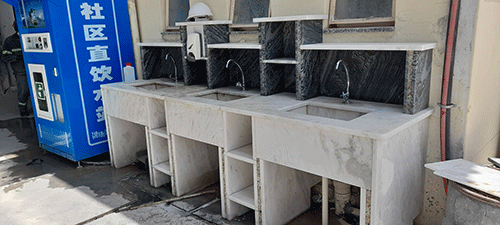KARIBIB – Some of the players in the dimension stone (marble) mining industry say they do not have the expertise, enough skilled human capital, or financial backing to add value and produce finished products as required by the government.
They highlighted this during a consultation held with Erongo governor Neville Andre to discuss challenges the industry faces in responding to the government’s call for value – addition and job creation in the multi-million-dollar industry, booming at Karibib.
There is currently only one factory in Karibib and another, Chinese-owned, outside Walvis Bay. A third is under construction at Karibib.
The mines ministry earlier revealed that the industry exported 65 800 tons of marble valued at N$274.7 million between 2020 and 2022, while contributing more than N$150 million to government coffers. Indications are also that it is growing at a rapid pace. There are 37 players in the industry.
However, some players say it will take years before all miners can export finished products due to a lack of investors as the process is highly capital-intensive. This is due to the high levies, royalties and other associated costs that make it difficult to also attract investors.
Jaco de Jager, general manager of Namagra, which is operating in Karibib, said they were told by the government to start a factory. However, not everyone in the sector is fortunate enough to have the finances available to start a factory.
“We took the liberty and started constructing our factory during the first stage of Covid-19. We are now in a position to say the factory is there, but we are facing so many challenges to get the factory up and going. Think about it this way: we are granite miners who were forced into the industry, and we don’t have any knowledge about or have people who can work on the floor and maintain the factory,” he explained.
According to De Jager, they acknowledge the government’s view of the sector, and appreciate the rules and regulations set up to protect and add value to the industry.
“We appreciate the rules and regulations, but it is going to take time. On the bright side, we have the resource and should exploit it responsibly,” he observed.
The chairman of the Karibib Dimension Stone Association, Michael Inyenga, also said the industry struggles with royalties, transport and export tariffs, which make Namibian marble very expensive and complicated for local investment.
“It’s capital-intensive, and most of the operators struggle to get financial backing. However, less than 10% of the stakeholders in the marble industry are Namibians. A handful of Namibian role-players are in the process of establishing a factory in the town, but need additional investments for local value-addition to take place,” he stressed.
He added that massive investment is likewise needed to set up training facilities that will allow the industry to get the necessary skills locally, instead of relying on foreign expertise.
The mines ministry’s spokesperson, Simon Andreas, said the miners are charged 5% as royalty by the ministry, while they are also charged a 15% export levy for raw material by the finance ministry.
He added that the ministry has been assisting the mining sector by developing the Mineral Beneficiation Strategy for value-addition.
“The strategy is being promoted under the NIPDB, which is a promotion arm of government to attract investors. The ministry also put a condition for mining companies to set aside 30% of their raw materials for value-addition if the industry exists in the country.
“However, there is a factory in Walvis Bay for value-addition, which is underutilised,” he observed.
Meanwhile, the governor also appealed to the industry to organise themselves in such a way that they can collectively address the challenges with the relevant authorities.
“There needs to be a collective approach to address all the challenges you face, seeing that the marble sector is vital not only for economic development and job creation, but also for the development of Karibib as a town,” Andre said.



